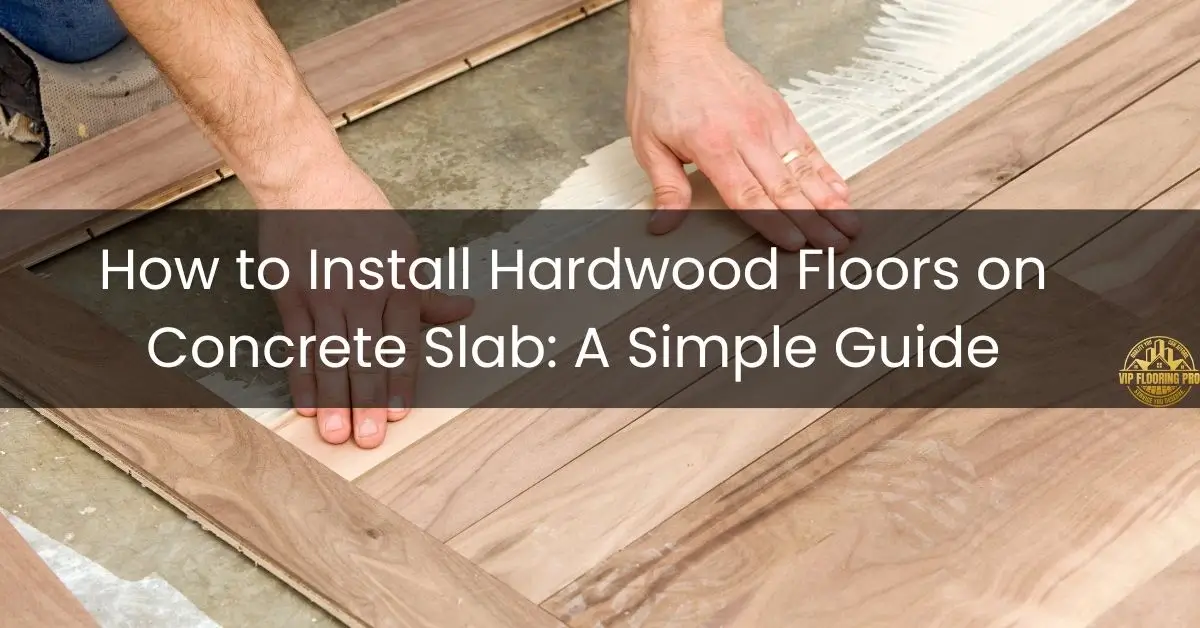Adding hardwood floors is always a great way to upgrade your home. They make every room look more beautiful. The natural materials combined with the smooth color of natural wood immediately create a warm and pleasant feeling. But if your home has a concrete slab, you might wonder: is it even possible to install hardwood floors? Is it a good idea? Don’t worry! In this blog, we’ll cover everything you need to know about installing hardwood floors on a concrete slab.”
Can You Install Hardwood Floors On A Concrete Slab?
Yes, you can install hardwood floors on a concrete slab, but some essential factors to consider are moisture control, subfloor preparation, installation methods, and surface preparation.
If the concrete is ready and the hardwood floors are installed by a professional, you can avoid any issues and ensure the job is done right by hiring the best contractors in your area.
Want to know the cost to install hardwood flooring? Click here
How to Install Hardwood Floors on a Concrete
Here are the steps to install hardwood floors on a concrete
At or Above Ground Level:
Solid hardwood floors can be installed on ground level or above slabs with dry concrete, the right subfloors, and vapor barriers. Moisturizers can cause problems for solid hardwood floors below ground level. However, it is safe to use engineered wood floors rather than solid hardwood.
Wooden floors should be far away from wet areas. Before delivering materials to the site:
- Ensure all outside windows and doors are installed.
- Ensure all concrete, drywall, and masonry are completely dry before installation. The building should have good airflow in warm weather.
- Keep the heat on in winter for at least five days before the flooring is delivered.
Subfloor Process:
The subfloor process is one of the most effective ways to install a hardwood floor. In this process, we insert a ¾-inch thick wooden base layer. This layer adds stability and a smooth surface to the hardwood, making it easy to install over concrete.
Prepare The Slab
If you have a new or old slab, ensure it is dry before installation. For the best outcome, test multiple areas of each room for unwanted wetness. If the moisture level in the slab is too high and the slab is new, let it dry naturally before installation. You can speed up the drying process with heat and good ventilation. In general, concrete slabs that are less than 60 days old are too wet and not suitable for hardwood floor installation.
Vapour Retarder
Before installing hardwood on concrete, put a moisture cover on the slab. This will prevent the typical slab from reaching completed work. Some standard options for this purpose include improving air quality and preventing condensation.
Acclimation
Ensure the flooring materials are delivered when the site is ready and stored in the rooms where they will be installed. For flooring less than 3 inches wide, the moisture difference between the wood and subfloor should be 4% or less. For flooring 3 inches or wider, the difference should be no more than 2%
Materials Needed for Installation:

Here are the materials which are essential for installing hardwood floors on a concrete slab
Hardwood Flooring:
The top layer you walk on gives the floor its look and strength. It’s installed with glue, nails, or staples.
Moisture Barrier (Vapor Barrier or Plastic Sheeting):
A protective sheet was placed under the hardwood to stop moisture from the concrete floor from ruining the wood.
Adhesive (for Glue-Down Installation):
A strong glue sticks hardwood planks directly to the floor, holding them in place.
Tape Measure:
A tool measured the room’s size, and hardwood planks were used to ensure everything fit properly.
Chalk Line:
A tool that marks a straight line on the floor, helping to lay the first row of planks in a straight line.
Notched Trowel:
A tool used to spread glue evenly on the floor when installing hardwood with glue.
Flooring Nails or Staples (for Nail-Down Installation):
Nails or staples hold the hardwood planks in place, usually along the edges.
Pneumatic Nail Gun or Hammer:
A tool that drives nails or staples into the wood quickly (nail gun) or by hand (hammer).
Circular Saw or Miter Saw:
Tools used to cut hardwood planks to the correct size, especially at the edges or corners.
Wood Filler (for Gaps or Imperfections):
After installation, a paste fills small holes or gaps in the wood, making the floor look smooth.
Advantages of Hardwood Flooring on a Concrete Slab
Hardwood floors are very popular and are of good use. Although it is a flooring option, it usually comes at a high price. Sometimes, people choose it because it comes with outstanding durability, low maintenance, and they are easy to clean. Hardwood floors can last for many years; they only require a small amount of fixing or coloring. They are easy to sweep or wash to remove dirt or dust. In addition to these practical benefits, hardwood floors
bring many style benefits, especially when installed over a concrete slab.
Here are some benefits:
Better looking
Standard concrete is uninteresting and boring, but after hardwood installation, your space will be completely upgraded. These floors have a great style and a luxurious look that can be easily combined with other design elements.
Warmness:
Concrete floors are usually cold and uncomfortable. By installing hardwood flooring over them, your space will become warmer and more comfortable.
Good Investment
Due to their luxury look and durability, hardwood floors are worth investing in. Potential homeowners will find them luxurious, which means your home will be of higher value than before.
Want to learn how long it takes to install hardwood floors? Then click here
Conclusion:
Installing hardwood floors on a concrete slab is possible and can make your home look more beautiful and feel warmer. You can ensure a successful installation by following the proper steps, like checking for moisture, preparing the concrete properly, and using the right materials. Whether you choose solid or engineered wood, using a suitable subfloor and vapor barrier will help protect your floors. With proper care and installation, your hardwood floors will look great and last long, making them a wise investment for your home. You can definitely give them a try.
For more inquiries, contact us on Instagram
FAQs:
Q1: What are the different installation methods for hardwood flooring on a concrete slab?
A: There are several installation methods for hardwood flooring on a concrete slab, including glue-down, nail-down (if using a subfloor), and floating installations. The glue-down method directly adheres the wood planks to the concrete slab with a unique adhesive. In contrast, the floating method uses interlocking planks that do not require glue or nails.
Q2: What’s the easiest way to install hardwood floors on concrete?
A: The two most common ways are glue-down and floating installation. In glue-down, you stick the hardwood directly to the concrete with special glue. In the floating method, the hardwood pieces lock together and “float” on top of the concrete without being glued.
Q3. How do I get the concrete ready before putting it on hardwood floors?
A: Make sure the concrete is level, clean, and dry. You may need to fix any uneven spots with a leveling compound and clean up dust or dirt. Also, check for moisture because too much water can damage the wood.
Q4. Do I need something under the hardwood floors when installing concrete?
A: Yes, you should use an underlayment, a layer placed between the concrete and hardwood. It helps protect the wood from moisture, reduces noise, and makes the surface smoother for installation
Q5: What are the best types of wood for flooring?
A: The best wood for flooring depends on durability and appearance. Oak is strong and versatile, maple is light and smooth, walnut is dark and rich, and cherry is warm and elegant. Due to their toughness, oak and hickory are top choices for high-traffic areas.




